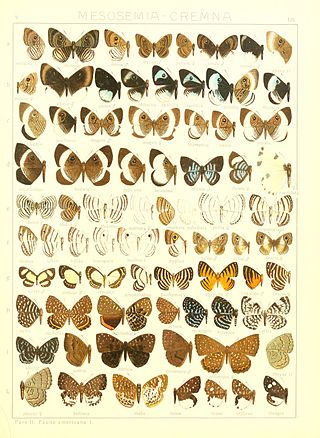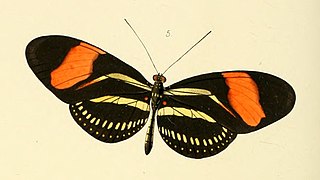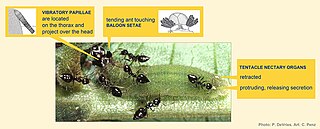
Lycaenidae is the second-largest family of butterflies, with over 6,000 species worldwide, whose members are also called gossamer-winged butterflies. They constitute about 30% of the known butterfly species.

Riodinidae is the family of metalmark butterflies. The common name "metalmarks" refers to the small, metallic-looking spots commonly found on their wings. The 1,532 species are placed in 146 genera. Although mostly Neotropical in distribution, the family is also represented both in the Nearctic, Palearctic, Australasian (Dicallaneura), Afrotropic, and Indomalayan realms.

Hamearis lucina, the Duke of Burgundy, the only member of the genus Hamearis, is a European butterfly in the family Riodinidae. For many years, it was known as the "Duke of Burgundy fritillary", because the adult's chequered pattern is strongly reminiscent of "true" fritillaries of the family Nymphalidae.

Taxila haquinus, the harlequin or orange harlequin, is a small but striking butterfly from the family Riodinidae. It is found from India east to Palawan and south to Java. It is the only species in the genus Taxila.

Riodininae is the largest of the three subfamilies within the metalmark butterfly family, Riodinidae.
Butterfly evolution is the origin and diversification of butterflies through geologic time and over a large portion of the Earth's surface. The earliest known butterfly fossils are from the mid Eocene epoch, between 40-50 million years ago. Their development is closely linked to the evolution of flowering plants, since both adult butterflies and caterpillars feed on flowering plants. Of the 220,000 species of Lepidoptera, about 45,000 species are butterflies, which probably evolved from moths. Butterflies are found throughout the world, except in Antarctica, and are especially numerous in the tropics; they fall into eight different families.

Zizeeria knysna, the dark grass blue or African grass blue, is a species of blue butterfly (Lycaenidae) found in Africa, on Cyprus and the Iberian Peninsula.

Eburna is a genus of sea snails, marine gastropod mollusks in the family Ancillariidae.
Abisara fylloides is a butterfly in the family Riodinidae. It is found in Asia.

Abisara rogersi, the light banded Judy, is a butterfly in the family Riodinidae. The species was first described by Herbert Druce in 1878. It is found in Nigeria, Cameroon, Angola, the Democratic Republic of the Congo, Uganda, Tanzania and Zambia. The habitat consists of shady areas in forests and open areas in submontane forests.

Hermathena candidata is a species of butterfly in genus Hermathena of the family Riodinidae. It is found from Costa Rica to Colombia, the Guianas and Bolivia east of Andes.

Hermathena is a genus of butterflies in the family Riodinidae containing a total of three known species. A small Neotropical genus of uncommon montane butterflies. The larvae feed on bromeliads.
Hermathena oweni, the peppered metalmark, is a species of butterfly in genus Hermathena of the family Riodinidae. It was first described by William Schaus in 1913. This rare montane forest species is found from southern Mexico to Costa Rica.

Heliconius hermathena, the Hermathena longwing, is a species of butterfly of the family Nymphalidae. It is endemic to white sand areas of the Amazon basin. Heliconius hermathena is a sand forest nymphalid butterfly and they are typically lowland tropical forest organisms although a handful subspecies can be found in southeastern Brazil and part of the dry forests of Peru.

Thermozephyrus ataxus, the wonderful hairstreak, is a small butterfly found from India to Japan that belongs to the lycaenids or blues family.

Singing caterpillars is a term coined by Philip James DeVries, referring to the fact that the larvae of ant-associated butterfly species of the families Riodinidae and Lycaenidae produce substrate borne sounds that attract ants. The study of these symbiotic associations was pioneered by Phil DeVries in Central America, and Naomi Pierce in Australia. Recently, Lucas Kaminski and collaborators are expanding the studies of riodinid-ant symbioses in Brazil.

Styx is a monotypic genus of butterflies in the metalmark family Riodinidae. It consists of one species, Styx infernalis, described by Otto Staudinger in 1875. It is endemic to Peru, where it inhabits tropical montane cloud forests between the elevations of 1000-1600 meters.












